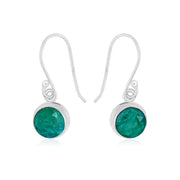Prized by royalty and paving its way to Cleopatra’s heart, Emerald jewellery has its own aura and a special place in every jewellery collection.

EMERALD
Belonging to the same family as aquamarine, emerald is also a variety of the mineral beryl. Prized for ages due to its vivid green colour, emerald is one of the top three major coloured gemstones, other than ruby and sapphire, due to its high value. Its colour ranges from pale to vivid green with slight blue undertones. It is the only gemstone to have a cut named after it, which is the 'emerald cut'. It is called 'Panna' in Hindi.
Cultural Significance
Having a long and rich history, Emerald is often associated with royalty, power, and wisdom. Emerald was highly valued in ancient Egypt and was sacred in some cultures. Cleopatra was famous for her love of emeralds. The mines near the Red Sea, known as Cleopatra's mines, were a major source of emeralds in the ancient world.
Benefits
Ranging from 7.5 to 8 on the Mohs scale, emeralds are fairly durable but softer than other gemstones like sapphire or diamond, having the following benefits :
- Relieves stress
- Improves Memory
- Brings protection and loyalty
- Calms the mind
- Symbolises rebirth and growth
- Enhance intuition
Astrological Significance
Vedic - In Vedic astrology, emerald is associated with mercury. It is believed to bring success and prosperity, enhancing the intellectual and analytical capabilities of the person wearing it. It is most beneficial in fields requiring intellectual abilities.
Western - In Western astrology, emerald is linked to the zodiac sign of Taurus. It is believed to bring peace and harmony and foster love in relationships. It is also attributed to Venus, beneficial for enhancing intuition.
Origin
Emeralds form in hydrothermal veins under high heat and pressure. The most famous and high-quality emeralds come from mines of Colombia. Another important source of emeralds is Zambia, known for producing stones with slightly bluish-green hue. Brazil also produces a significant amount of emeralds, lighter in colour as compared to Colombian ones. Emeralds are also found in other countries like Afghanistan, Zimbabwe, Pakistan, and Madagascar.
Environmental Impact
Though emerald mining provides economical benefits, it is very important to keep these processes in check as they have a severe impact on their surroundings and the environment as a whole. Sustainable mining practices and responsible management are necessary to reduce land disturbance, habitat loss, and water contamination and to balance resource extraction with environmental conservation and community well-being.





